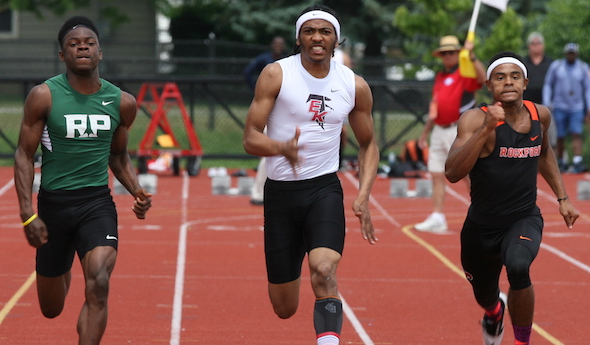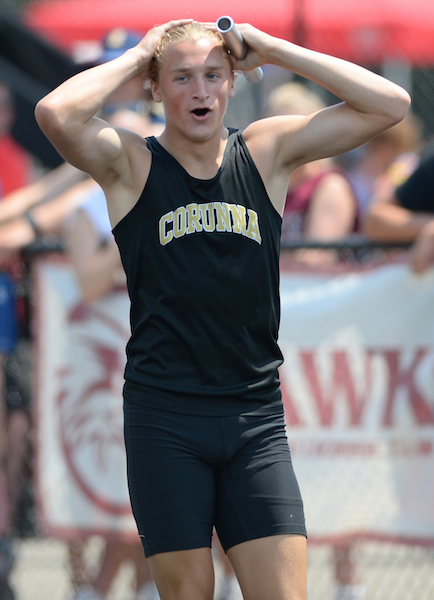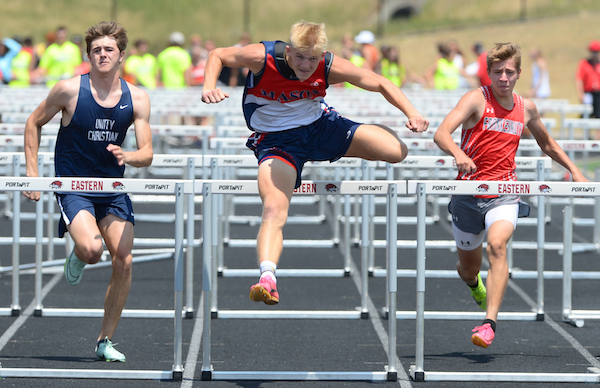
Meyers Gives Kentwood Crowd Final Show
By
Paul Costanzo
Special for MHSAA.com
June 3, 2017
Khance Meyers put on one final show in an East Kentwood uniform Saturday, and did it on his home track.
The senior sprinting star won the 100 and 200 meters for the second straight year at the Lower Peninsula Division 1 Boys Track & Field Finals, and anchored the winning 800 relay team also to a repeat championship.
“Doing all this on my home turf feels amazing,” said Meyers, who also anchored the runner-up 1,600-relay team. “Just knowing that you’re at home, competing against the best, the top in the state, some even nationally ranked, it’s just amazing. Coming out here, giving the fans what they want, giving them a show – all I can say is I thank God that I’m able to do this.”
Meyers’ performance led an all-around remarkable day for the Falcons, who finished with 78½ points to claim their first MHSAA team title since 2014. It was the school’s sixth title under coach Dave Emeott. Rival Rockford was second with 62 points, followed by defending champion Oak Park in third with 44.
“Ultimately it was a full team approach,” Emeott said. “We won a bunch of events, and we set a state record in the long jump and ended up second place; that doesn’t happen very often. Our kids were on fire, every event. I’m so proud of them.”
Meyers set the Division 1 meet record in the 100 meters with his time of 10.53 seconds. He just missed breaking his own 200-meter record, winning in 21.27. He joined teammates Al Jeffries, Jacobie Welch and Stephan Bracey to run 1:26.07, breaking the Division 1 meet record East Kentwood set a year ago.
“People ask me all the time, ‘Khance, how does it feel to be No. 1 in the state?’ or ‘How does it feel to be competing at the top level?’” Meyers said. “Just being No. 1 in the 100, 200 and dropping your times -- all I can say is, I just thank God.”
Meyers wasn’t the only Falcon to take home an individual title, as sophomore thrower Logan Brown won the shot put with a toss of 60 feet, 1½ inches.
He also wasn’t the only record setter on the day. Salem’s Mason Phillips won the long jump with a leap of 24-2¾, the best mark not only in Division 1 meet history, but for all Finals.
Rockford’s 400-meter relay team did the same, as their time of 41.2 seconds is a new top mark in MHSAA Finals history. The team included Melvin Moseley, Noah Stallworth, Josh Patterson and Nicholas Isley.
Like Meyers, Oak Park’s Cameron Cooper came away with three titles and one runner-up finish. He won the 800 in 1:51.22, teamed with Dewan Hawthorne, Bryce Pickett and Javonne Kirksey to win the 1,600 relay in 3:17.58, and teamed with Hawthorne, Kirksey and Michael Campbell to win the 3,200 relay in 7:44.85. He was second in the 1,600 meters, edged out at the line by Rockford’s Cole Johnson.
“I just ran it,” Cooper said of the 800. “I had to come back after all of those events -- I can’t really feel my legs. I’m kind of used to (running four events) because I do it throughout the year, sometimes even doing two meets a week. I’m really strong, so I can come back and still run the same thing.”
For Johnson, his 1,600 win was a redemption story. He stumbled early in the race a year ago, but bounced back to take third. This year, he got out fast and won in 4:08.60, despite a late push from Cooper.
“Since I wanted to run fast, I had to be out there pushing the pace,” Johnson said. “I definitely learned from my fall last year to get out fast. I knew that I could go out in sub-60 (seconds on the first lap) because that’s what I went out at in an MSU meet earlier this year. I definitely wanted to get out fast.”
East Lansing’s Kentre Patterson doubled in the hurdle races, winning the 110 in 13.84 and the 300 in 38.23 seconds despite not running in the final heat. It was the second straight title for Patterson in the 110 hurdles.
“I always love competition, but being in the slow heat, kind of controlling the race was pretty good,” Patterson said. “It let me relax and do my own thing. I didn’t put my clothes back on until after (the final heat).
“I just had it in my head that this is the last race of the season, last time running the 300 hurdles. My coaches had me thinking about it all week, telling me I could do it coming out of the slow heat.”
Ypsilanti Lincoln’s Matthew Moorer won the 400 meters in 47.42 seconds. Fenton’s Dominic Dimambro won a tight 3,200-meter race in 9:07.79.
Randy Prince of Portage Northern won the discus with a throw of 173 feet. Connor Bush of Plymouth won the high jump with a jump of 6-6. Cale Snyder of Macomb Dakota won the pole vault, clearing 15-6.
PHOTO: East Kentwood's Khance Meyers pushes past his competitors during a sprint win Saturday. (Photo by Carter Sherline/RunMichigan.com.)

Vicksburg's Wright, Corunna Right On in Claiming LPD2 Championships
By
Steve Vedder
Special for MHSAA.com
June 3, 2023
ADA – If Michael Wright was a baseball player, he probably would've been called out on strikes a year ago.
Instead, the Vicksburg senior can celebrate after winning the 200 at Saturday's Lower Peninsula Division 2 Track & Field Finals at Forest Hills Eastern.
The road to the championship in the 200, via a time of 21.72, was anything but a straight line for Wright. An aspiring baseball player, he was cut from the Vicksburg squad as a freshman. His football career, by Wright's own admission, was "on and off." And then a year ago in his first track meet, Wright suffered a leg injury that virtually ended his season. He did return to finish fifth in the 200 at Finals while helping the 400 relay team to a 16th place.
So there is nothing to realistically explain how Wright found himself in the position Saturday at sweltering Forest Hills Eastern to win a championship. Except for returning this season to break the school record in the 200 four times in two months. Well, that and willpower and simple desire.
 "I knew I could finish high, maybe in the top five. But this is better," said Wright, who credits drinking large quantities of milk for his resurgence. "I looked to football because I didn't think I could bounce back for track. But I overcame the bumps, the obstacles."
"I knew I could finish high, maybe in the top five. But this is better," said Wright, who credits drinking large quantities of milk for his resurgence. "I looked to football because I didn't think I could bounce back for track. But I overcame the bumps, the obstacles."
While Wright was jump-starting his track career, Corunna won the team title with 41 points. Mason and Forest Hills Eastern tied for second with 35. Whitehall was fourth with 33 points, and Frankenmuth fifth with 29 points.
Corunna coach Jeff Sawyer, who had never won a Finals title in 37 years coaching at Owosso and three more at Corunna, said the championship came after little fanfare during the season. Virtually right up until the time Corunna hauled off its first-place trophy, Sawyer said it was never really on his team's mind. The title came after the team managed only a runner-up finish at the Regional.
"We kind of low-keyed it," he said. "We knew scoring 40 points was possible. We lost to Frankenmuth by one point at the Regional. … We were a little disappointed we didn't win, but we had some good times today. We knew it was possible.
"Every day we just come and do what we do. We talk about getting better every day with PRs (personal records). And we're still getting better because we have some tough guys. Just competitive, tough kids. But we were the underdogs."
Corunna had only two firsts on Saturday, in the 400 relay (42.63) and Wyatt Bower in the long jump (22-8½).
Among the individual highlights was Frankenmuth senior Dalton DeBeau, who successfully defended his Finals title in the discus (171-6). He was fifth in that event as a sophomore and after winning a year ago, was considered a good bet to repeat.
"I kind of expected it," said DeBeau, who will compete at Michigan State next spring. "There wasn't a lot of pressure. I knew what had to be done. I threw 160 feet on my first throw to get in the finals, and that helped right away. I knew I could go all out."
 Berrien Springs' Jake Machiniak won the 100 (10.54) while the team also captured the 800 relay (1:28.18). Machiniak said his season hasn't been without its share of difficulties. There was a time when he couldn't seem to come out of the starting blocks smoothly. But beginning with the conference meet where he ran school record 10:73, Machiniak felt himself back on course.
Berrien Springs' Jake Machiniak won the 100 (10.54) while the team also captured the 800 relay (1:28.18). Machiniak said his season hasn't been without its share of difficulties. There was a time when he couldn't seem to come out of the starting blocks smoothly. But beginning with the conference meet where he ran school record 10:73, Machiniak felt himself back on course.
"There were ups and downs. I struggled in the middle of the season," he said. "But my teammates helped me through some difficulties. I came here to finish the job; I knew I could do something here."
Mason's Tyler Baker won the 100 hurdles (14.63) to complete a long journey that included finishing just ninth in last year's prelims. The success was as simple as putting in loads of offseason work.
"I practiced and did stuff about every day," he said. "I might not be the fastest, but I make up for that in form. It's a fine-tuning thing. Everyone wants to be faster."
Mason also got a championship from A.J. Mantel, who captured the 300 hurdles (38.90).
Among other highlights was Forest Hills Eastern senior Aiden Sullivan successfully defending a 2022 title on his own home turf. He won Saturday's 800 (1:53.92).
Adrian won the 3,200 relay (7:39.77), while Grand Rapids Christian took the 1,600 (3:24.49).
Alma had two individual winners in Michael Howey in the shot (55-08) and Jacob Dunlap in the high jump (6-7).
The other champs were Kyle Eberhard of Linden in the 1,600 (4:14.79), Whitehall's Trannon Ayler in the 400 (48.83), Freeland's T.J. Hansen in the 3,200 (9:11.56) and Sam Vesperman of Grosse Ile in the pole vault (15.01). Chelsea senior Jacob Nelson competed in the adaptive 100 (27.28), 200 (57.71) and shot put (6-6).
PHOTOS (Top) Vicksburg's Michael Wright celebrates after winning the 200 on Saturday. (Middle) Corunna's Tarick Bower enjoys a moment after anchoring the winning 400 relay. (Below) Mason's Tyler Baker, center, works to stay ahead in the 110 hurdles. (Photos by Dave McCauley/RunMichigan.com.)

